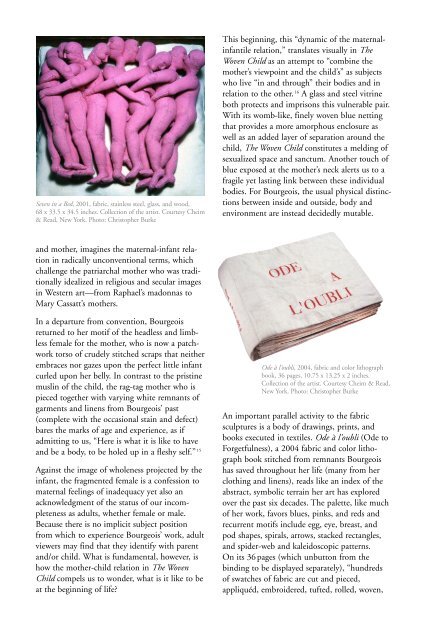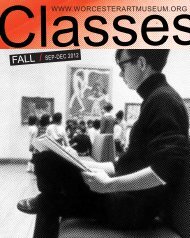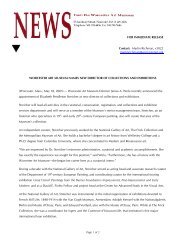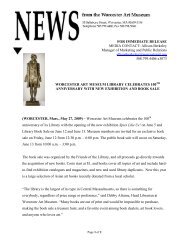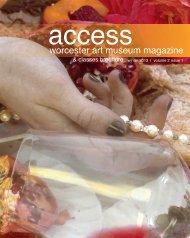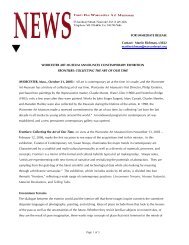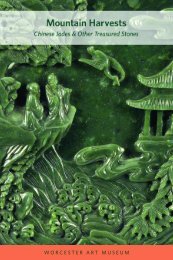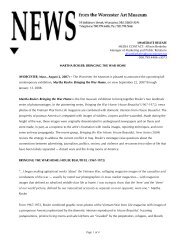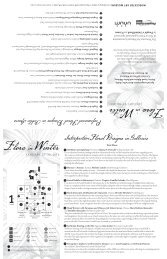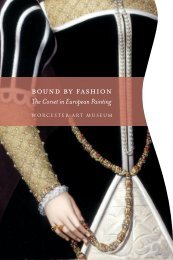Create successful ePaper yourself
Turn your PDF publications into a flip-book with our unique Google optimized e-Paper software.
Seven in a Bed, 2001, fabric, stainless steel, glass, and wood,68 x 33.5 x 34.5 inches. Collection of the artist. Courtesy Cheim& Read, New York. Photo: Christopher BurkeThis beginning, this “dynamic of the maternalinfantilerelation,” translates visually in TheWoven Child as an attempt to “combine themother’s viewpoint and the child’s” as subjectswho live “in and through” their bodies and inrelation to the other. 16 A glass and steel vitrineboth protects and imprisons this vulnerable pair.With its womb-like, finely woven blue nettingthat provides a more amorphous enclosure aswell as an added layer of separation around thechild, The Woven Child constitutes a melding ofsexualized space and sanctum. Another touch ofblue exposed at the mother’s neck alerts us to afragile yet lasting link between these individualbodies. For Bourgeois, the usual physical distinctionsbetween inside and outside, body andenvironment are instead decidedly mutable.and mother, imagines the maternal-infant relationin radically unconventional terms, whichchallenge the patriarchal mother who was traditionallyidealized in religious and secular imagesin Western art—from Raphael’s madonnas toMary Cassatt’s mothers.In a departure from convention, Bourgeoisreturned to her motif of the headless and limblessfemale for the mother, who is now a patchworktorso of crudely stitched scraps that neitherembraces nor gazes upon the perfect little infantcurled upon her belly. In contrast to the pristinemuslin of the child, the rag-tag mother who ispieced together with varying white remnants ofgarments and linens from Bourgeois’ past(complete with the occasional stain and defect)bares the marks of age and experience, as ifadmitting to us, “Here is what it is like to haveand be a body, to be holed up in a fleshy self.” 15Against the image of wholeness projected by theinfant, the fragmented female is a confession tomaternal feelings of inadequacy yet also anacknowledgment of the status of our incompletenessas adults, whether female or male.Because there is no implicit subject positionfrom which to experience Bourgeois’ work, adultviewers may find that they identify with parentand/or child. What is fundamental, however, ishow the mother-child relation in The WovenChild compels us to wonder, what is it like to beat the beginning of life?Ode à l’oubli, 2004, fabric and color lithographbook, 36 pages, 10.75 x 13.25 x 2 inches.Collection of the artist. Courtesy Cheim & Read,New York. Photo: Christopher BurkeAn important parallel activity to the fabricsculptures is a body of drawings, prints, andbooks executed in textiles. Ode à l’oubli (Ode toForgetfulness), a 2004 fabric and color lithographbook stitched from remnants Bourgeoishas saved throughout her life (many from herclothing and linens), reads like an index of theabstract, symbolic terrain her art has exploredover the past six decades. The palette, like muchof her work, favors blues, pinks, and reds andrecurrent motifs include egg, eye, breast, andpod shapes, spirals, arrows, stacked rectangles,and spider-web and kaleidoscopic patterns.On its 36 pages (which unbutton from thebinding to be displayed separately), “hundredsof swatches of fabric are cut and pieced,appliquéd, embroidered, tufted, rolled, woven,


